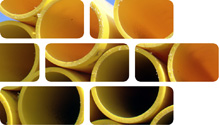
Plastic Pipes Plastic 17 02 03
Plastic pipes and associated fittings and collars are generally made from polypropylene, polyethelyne and polyvinyl. They are produced in various styles, sizes and thicknesses, depending on the specification required, their intended use and/or design criteria. They are of varying quality and finish to suit the demands of their intended use and performance.
Usage & Probable Locations
Plastic pipes are mostly used to tranfer liquids, gases, slurries, wastes, fuels and cables. They are used for pipework, conduits, potable water, sewage, drainage, rainwater systems, fuel and under floor heating. Pipes are generally located in groundworks, under the floor, in kitchens, bathrooms and service ducts.
Personal Protective Equipment
PPE requirements indicated are for guidance purposes only. DRIDS has identified the PPE that is mandatory on all demolition projects and ones that may be required subject to site specific Risk Assessment & Method Statement (RAMS). Hover over the icon to determine the types of PPE required for the removal of this material.
Removal, Segregation & Storage
Plastic pipes that are destined for reuse should be deconstructed, segregated and stored carefully and safely, especially those in good condition and not coated with glues or bitumen at the collar. They should be stored flat and in bound bundles to prevent warping. They should also be stored away from plant movements to prevent damage. Plastic pipes destined for recycling or energy recovery need less protection and should be stored in a plastic recycling skip. There is little need to store plastic skips under cover as they are robust against inclement weather.
Tools
Fixtures, Fittings & Connections
Plastic pipes have been traditionally fitted together using a pipe and collar connection that is sealed with a suitable grout or mastic and occasionally tightened with a collar clip.. Some pipework that acts as a conduit for cables or other pipes require no fixings, grout or sealant, rather they are built into a trench with made-up ground or hang within a suspended floor or ceiling. Rainwater systems will be fixed to walls and fascia boards using a range of brackets screwed or nailed in place. Under floor heating pipes will be clipped in place with brackets or pressed into the grooves of polystyrene boards. Pipes are rarely painted, coated or protected.
Health & Safety
Subject to task-specific Risk Assessment & Method Statement (RAMS). Use correct protective equipment. Wear gloves to handle pipes and collars used for fuels, fluids, sewage and slurries to prevent irritation, cuts and biohazards. Wear eye protection when using hand tools. Do not walk on wet pipes. Use harness protection at height. Only use 360 plant, attachments or cutting tools if properly trained. Be alert to Weil’s Disease. Pipes may contain residues of hazardous materials.










